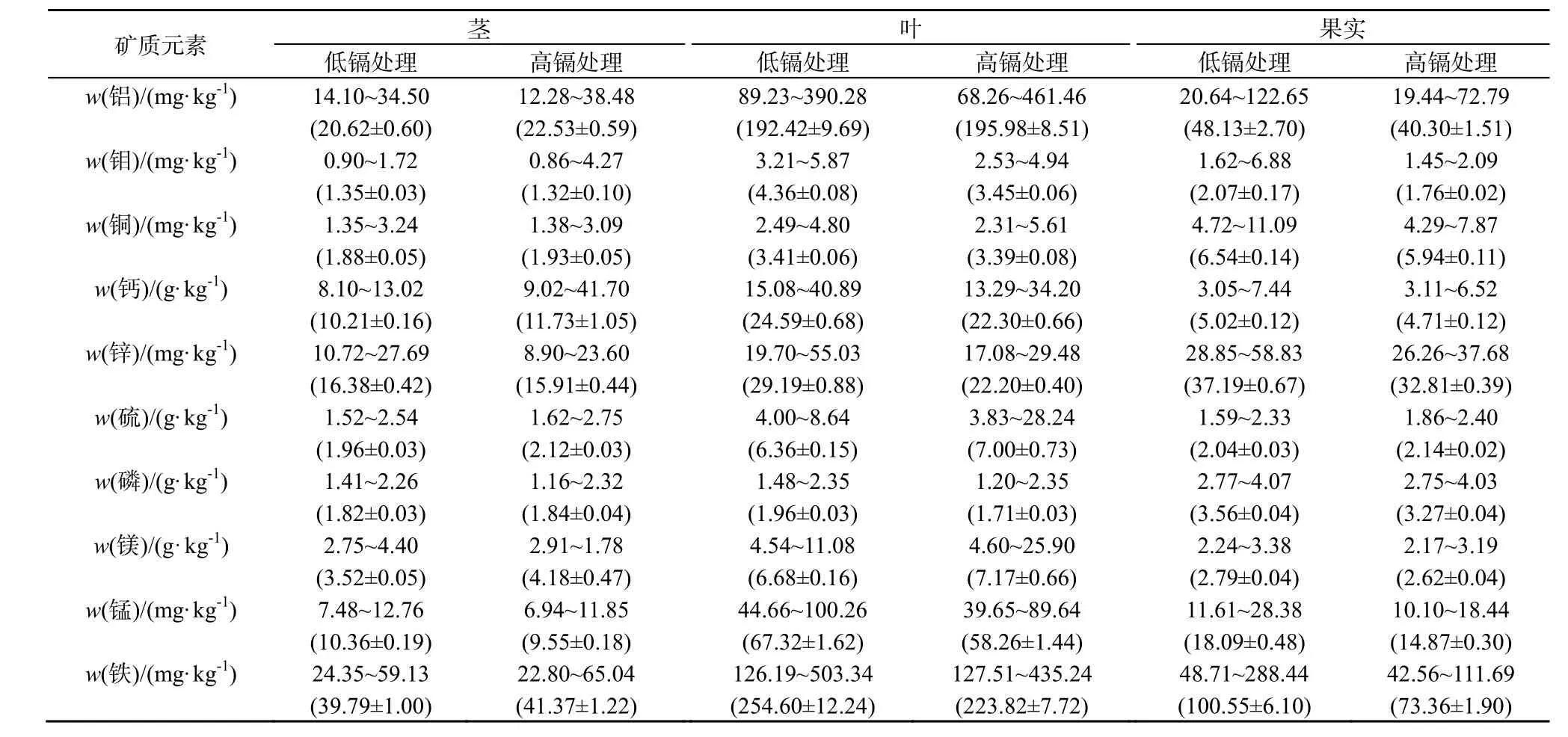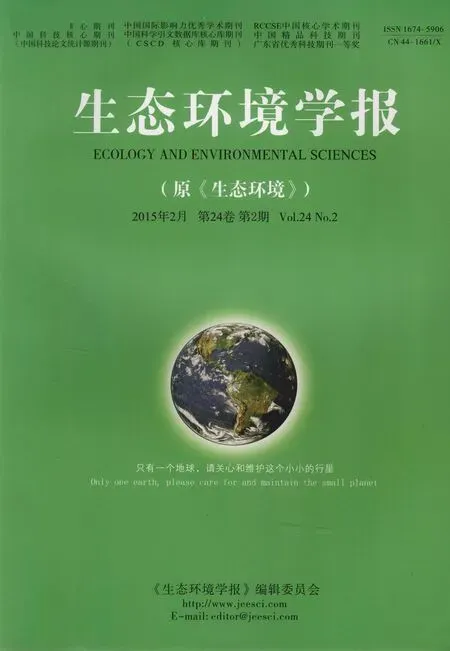鎘脅迫下蓖麻對鎘及礦質元素的富集特征
張晗芝,郭慶軍*,楊俊興,陳同斌,陳輝,申建秀,朱光旭,王鑫,孫野
1. 沈陽環境科學研究院,遼寧 沈陽 110016;2. 中國科學院地理科學與資源研究所環境修復中心,北京 110011;3. University of Technology, Sydney, Sydney 2007
鎘脅迫下蓖麻對鎘及礦質元素的富集特征
張晗芝1,2,郭慶軍2*,楊俊興2,陳同斌2,陳輝1,申建秀3,朱光旭2,王鑫1,孫野1
1. 沈陽環境科學研究院,遼寧 沈陽 110016;2. 中國科學院地理科學與資源研究所環境修復中心,北京 110011;3. University of Technology, Sydney, Sydney 2007
目前中國農田遭受鎘污染的情況日益嚴重。蓖麻(Ricinus communis L.)是一種能源作物,同時對鎘有較高的耐性和富集能力,因此利用蓖麻資源為合理利用鎘污染農田提供了一種可行的途徑。在溫室條件下(5~32 ℃)采用盆栽試驗,設定2個鎘質量分數梯度(2.396和5.396 mg·kg-1),研究鎘脅迫下30種蓖麻品種莖、葉和果實對鎘和礦質元素(鋁、鉬、銅、鈣、鋅、硫、磷、鎂、錳和鐵)吸收和富集特征,以及礦質營養元素與鎘富集的相關性。結果表明:鎘在不同組織的分布情況為莖>葉>果實,鋁、鉬、硫、錳和鐵在不同組織的分布為葉>果實>莖,鈣和鎂在不同組織的分布為葉>莖>果實,銅、鋅和磷在不同組織的分布為果實>葉>莖。在低鎘質量分數(2.396 mg·kg-1)處理條件下,莖、葉和果實中鎘質量分數變化范圍分別為0.600~1.670、0.310~1.970和0.130~0.909 mg·kg-1,平均值分別為1.030、0.831和0.362 mg·kg-1。在高鎘質量分數(5.396 mg·kg-1)處理條件下,莖、葉和果實中鎘質量分數變化范圍分別為1.012~4.032、0.698~3.514和0.227~1.525 mg·kg-1,平均值分別為1.964、1.583和0.694 mg·kg-1。蓖麻莖、葉和果實對鎘和礦質元素(鋁、鉬、銅、鈣、鋅、硫、磷、鎂、錳和鐵)的富集受蓖麻品種和土壤中鎘含量的顯著影響。鈣、硫、鎂、鐵的積累與鎘的吸收呈顯著正相關關系;鋅、錳、銅、磷的積累與鎘的吸收呈顯著負相關關系,而鋁、鉬的積累與鎘的吸收無顯著相關關系。因此,合理調控污染土壤中礦質元素的含量可以提高蓖麻對鎘污染土壤的修復效率。
鎘;蓖麻;礦質元素;農田
鎘污染逐漸引起全球的關注,是土壤中最普遍存在的污染物之一(Thévenod,2009;Huang等,2011)。鎘污染主要來自人為污染源,主要包括磷肥的使用,化石燃料的灰塵,水泥和冶金工廠的廢棄物,市政垃圾和污泥污水,以及大氣沉降(Pan等,2010;Reeves等,2008)。而且鎘在環境中不能降解,容易通過食物鏈從土壤中轉移到人體,危害人類的健康(Jarup,2003)。因此,我們必須采取措施修復鎘污染的土壤,防止鎘通過食物鏈危害人類健康。
蓖麻(Ricinus communis L.)是大戟科蓖麻屬一年生或多年生草本C3植物,起源于熱帶的亞洲和非洲。蓖麻具有巨大的根系,生物量大,生長勢強,能適應很廣泛的地理環境,在中國各地均有種植。蓖麻被認為是一種潛在的修復鎘污染土壤的植物(Bauddh和Singh,2012b;Huang等,2011)。另外,蓖麻是一種非食用的經濟作物,是一種生物燃料和生物柴油生產的能源作物(Berman等,2011;Da Silva等,2006)。因此蓖麻的種植能解決兩個重要的全球難題:日益增加的能源需求和鎘污染農田的修復(Olivares等,2013)。
重金屬能夠和必須大量元素和微量元素相互作用,因此顯著影響植物營養元素的吸收(Pál等,2006)。研究表明,鎘脅迫下,水稻(Liu等,2003a)、大麥(Chen等,2007)、小麥(Zhang等,2002)和遏藍菜(Dechamps等,2005)等植物種類的不同品種中礦質元素和鎘的富集呈相關性。
研究發現,23種蓖麻品種對鎘的富集能力具有巨大的差異(Huang等,2011)。目前,鎘脅迫下不同蓖麻品種對礦質元素的吸收特征的研究還很少,而且礦質元素和鎘吸收是否具有相關性還不是很清楚。本試驗研究了土壤中不同鎘質量分數(2.396和5.396 mg·kg-1)脅迫下,30種蓖麻品種對鎘和礦質元素(鋁、鉬、銅、鈣、鋅、硫、磷、鎂、錳和鐵)的富集特征,以及鎘和礦質元素吸收的相關性研究,探討通過調控鎘污染土壤中礦質元素的含量提高鎘植物提取效率的可能性。
1 材料與方法
1.1 試驗設計
本試驗為盆栽試驗,在溫室內進行。溫室的溫度為5~32 ℃。試驗所用土壤為褐土土類,采集于山東省淄博市張店區的一個菜園地,然后風干和過1 cm篩。土壤的基本性狀:總氮1.36 g·kg-1,總磷2.75 g·kg-1,有效磷79.0 mg·kg-1,有機質19.3 g·kg-1,CEC 262 mmol·kg-1,鎘0.396 mg·kg-1,pH6.7。
試驗設為2個處理:低鎘水平(2 mg·kg-1)和高鎘水平(5 mg·kg-1),每個處理3個重復,每盆裝6 kg準備的土壤,用CdCl2·2.5H2O(優級純)的水溶液調節土壤中鎘的濃度。最終,低鎘處理和高鎘處理的土壤鎘質量分數分別為 2.396和 5.396 mg·kg-1。鎘處理的土壤平衡4個月。2012年11月24日,由淄博市農業科學院提供30種蓖麻品種的種子直接播種在盆中,每盆播種3粒,共計180盆。蓖麻生長1個月后,每盆保留1棵。2013年5月24日收獲蓖麻(根、莖、葉、果實),生長周期為6個月。
1.2 植物樣品的準備和化學分析
收獲后的植物樣品分為根、莖、葉和果實4個部分。每個樣品先用自來水沖洗3遍去除土壤顆粒,然后用去離子水沖洗3遍,最后放到烘箱里烘干。烘箱開始設定110 ℃,烘0.5 h,然后設定為70 ℃直至樣品完全干燥。植物干質量用電子天平稱質量(最低稱樣量0.1 mg)。
莖、葉和果實分別磨碎后,用濃硝酸在電熱板上消解。消解溫度開始設定 60 ℃,然后升高到110 ℃并保持直到樣品溶液變澄清(Alexander等,2006;Zhang等,2014)。樣品溶液定容到25 mL。鎘、鋁、鉬、銅、鈣、鋅、硫、磷、鎂、錳和鐵的濃度用電感耦合等離子體發射光譜測定(Optima 5300 DV, America)。測定工作在中國科學院地理科學與資源研究所理化分析中心進行。
1.3 統計分析
數據采用SPSS 18.0軟件,用方差分析和相關分析的方法進行統計分析。所用指標采用3個重復。數據表示為平均值±誤差,用Duncan’s檢驗顯著性差異(P<0.05)。
2 結果與分析
2.1 蓖麻不同組織中鎘的濃度
蓖麻莖、葉、果實中鎘的含量受蓖麻品種(P<0.01)、土壤中鎘含量(P<0.01)、以及蓖麻品種和土壤中鎘含量交互作用(P <0.01)的顯著影響(表1)。鎘在不同組織的分布情況為莖>葉>果實。在低鎘處理條件下,莖、葉和果實中鎘質量分數變化范圍分別為0.600~1.670、0.310~1.970和0.130~0.909 mg·kg-1,平均值分別為 1.030、0.831和 0.362 mg·kg-1。在高鎘處理條件下,莖、葉和果實中鎘質量分數變化范圍分別為 1.012~4.032、0.698~3.514和0.227~1.525 mg·kg-1,平均值分別為1.964、1.583和0.694 mg·kg-1。
2.2 蓖麻不同組織中礦質元素的濃度
30種蓖麻品種莖、葉和果實中鋁、鉬、銅、鈣、鋅、硫、磷、鎂、錳和鐵質量分數見表2。鋁、鉬、硫、錳和鐵在不同組織的分布為葉>果實>莖,鈣和鎂在不同組織的分布為葉>莖>果實,銅、鋅和磷在不同組織的分布為果實>葉>莖(表2)。蓖麻莖葉果實中鋁、鉬、銅、鈣、鋅、硫、磷、鎂、錳和鐵質量分數數據基本服從正態分布。雙因素方差分析表明,蓖麻莖、葉和果實中鈣、錳和鐵質量分數受土壤中鎘含量、蓖麻品種和兩者交互作用的顯著影響(表3)。
2.3 蓖麻不同組織中鎘和礦質元素的相關性
低鎘和高鎘脅迫下蓖麻莖、葉和果實中鎘和鋁、鉬沒有相關性(表4)。蓖麻莖中硫、鐵和鎘呈正相關關系,葉中鈣、硫、鎂和鎘呈顯著正相關關系;而莖中鋅和錳、葉中銅和磷、果實中銅和鋅與鎘呈顯著負相關關系(表4)。
3 討論
以前的研究表明,花生(Arachishypogaea L.)(Mclaughlin等,2000)、大豆(Glycine max L.)(Ishikawa等,2005)、柳樹(Salix babylonica L.)(Granel等,2002)、馬鈴薯(Solanumtuberosum L.)(Dunbar等,2003)的不同品種對鎘的富集具有顯著差異。植物體內鎘的富集及分布與植物的種類及品種,生長條件有關(Arao等,2003;Arao和Ishikawa,2006;Grant等,2008)。本研究發現,鎘在蓖麻地上部分的富集及分布受蓖麻品種及土壤中鎘含量的影響(表1)。鎘在植物體內的富集和分布也受到遺傳因素的影響,包括根系分泌物的種類和數量,細胞內結合位點,木質部的運輸和卸載,韌皮部的運輸和液泡的區隔化(Grant等,2008)。

表1 不同鎘濃度脅迫下30種蓖麻品種不同組織中鎘的質量分數Table 1 Cd concentrations in different tissues among 30 cultivars of castor under low-Cd and high-Cd exposures

表2 低鎘和高鎘脅迫下30種蓖麻品種不同組織中礦質元素質量分數的變化范圍(平均值)Table 2 Range (average) of mineral elements concentrations in different tissues among 30 cultivars of castor under low-Cd and high-Cd exposures

表3 低鎘和高鎘脅迫下30種蓖麻品種不同組織中礦質元素質量分數的方差分析Table 3 ANOVA of mineral elements concentrations in different tissues among 30 cultivars of castor under low-Cd and high-Cd exposures

表4 低鎘和高鎘脅迫下30種蓖麻品種不同組織中鎘和礦質元素相關系數(n=60)Table 4 Correlation coefficients between Cd and mineral elements in different tissues among 30 cultivars under low-Cd and high-Cd exposures (n = 60)
鎘的吸收能夠影響植物光合作用、呼吸作用、生長以及營養元素的積累,比如鈣、鐵、銅、鎂和錳(Jalil等,1994)。研究表明,植物中大量元素的積累與鎘的吸收緊密相關,但是沒有同一定論。蓖麻對鈣、硫、鎂和鐵的吸收和鎘的吸收呈顯著正相關關系,而鋅、錳、磷的吸收和鎘吸收呈顯著負相關關系(表4),表明鈣、硫、鎂、鐵的積累和鎘的吸收是協同作用,而鋅、錳、磷的積累和鎘的吸收是拮抗作用。Liu等(2003b)研究表明,鎘和鋅、鐵、銅的吸收呈顯著正相關關系,而鎘與錳、鎂的吸收的相關性與植物生育期、植物組織有關。Chen等(2007)研究發現,錳的積累和鎘的吸收在不同大麥品種中呈協同作用,鋅、銅、鐵的積累和鎘的吸收呈不顯著的正相關關系。Zhang等(2002)研究發現,不同的小麥品種、植株組織影響鎘對鐵、鋅、銅、鈣和鎂的積累和轉運。Liu等(2003a)研究發現,不同品種水稻中鐵、鋅、銅的積累與鎘的吸收呈協同作用,錳的積累與鎘的吸收的相關性與植物組織也有關系,而鎂的積累與鎘的吸收沒有顯著相關性。
植物營養元素在植物忍耐鎘的毒害方面發揮重要作用,能夠有效減低植物不同部位中鎘的富集(Sarwar等,2010)。土壤中鎘含量的增加,蓖麻莖、葉和果實中鋅含量顯著減少(表3),可能是鎘通過鋅轉運通道進入細胞(Küpper和Kochian,2010)。本研究還發現其它礦質元素在莖或葉或果實中的含量顯著降低(表3),或者歸因于鎘的毒性抑制了礦質元素的吸收(Mendoza-Cózatl等,2008),也可能是鎘脅迫下植物的外排機制導致其它離子的流出(Migocka等,2007)。隨著鎘脅迫的增加,蓖麻莖中鈣含量增加,能抑制蛋白中鈣離子被鎘離子替代,可能導致鎘抑制植物光合作用(Faller等,2005)。蓖麻葉和果實中鎂積累的增加(表2)能夠減輕鎘的毒害,因為更多的鎂存在于葉綠體中能夠抑制鎘結合葉綠素或酶的催化位點(Küpper和Kochian,2010;Küpper等,2002)。蓖麻中硫含量的增加可合成谷胱甘肽、金屬硫蛋白和植物螯合態等硫配位體結合鎘離子(Cobbett和Goldsbrough,2002)。
4 結論
30種蓖麻品種對鎘和礦質元素(鋁、鉬、銅、鈣、鋅、硫、磷、鎂、錳和鐵)的富集能力不同;鎘和礦質元素在蓖麻地上組織的富集受蓖麻品種和土壤中鎘含量的顯著影響。鎘在地上組織的分布情況為莖>葉>果實,鋁、鉬、硫、錳和鐵在不同組織的分布為葉>果實>莖,鈣和鎂在不同組織的分布為葉>莖>果實,銅、鋅和磷在不同組織的分布為果實>葉>莖。
鈣、硫、鎂、鐵的積累與鎘的吸收呈顯著正相關關系;鋅、錳、銅、磷的積累與鎘的吸收呈顯著負相關關系,而鋁、鉬的積累與鎘的吸收無顯著影響。元素種類、蓖麻品種、植物組織、土壤中鎘含量影響蓖麻中礦質元素的積累。同樣,鈣、鎂、硫等礦質元素積累的增加參與鎘的解毒過程中。因此,我們可以通過合理調控鎘污染土壤中礦質元素的含量,提高蓖麻對鎘污染土壤的修復效率。
ALEXANDER P D, ALLOWAY B J, Dourado A M. 2006. Genotypic variations in the accumulation of Cd, Cu, Pb and Zn exhibited by six commonly grown vegetables [J]. Environmental Pollution, 144(3): 736-745.
ARAO T, AE N, SUGIYAMA M, et al. 2003. Genotypic differences in cadmium uptake and distribution in soybeans [J]. Plant and Soil, 251(2): 247-253.
ARAO T, ISHIKAWA S. 2006. Genotypic differences in cadmium concentration and distribution of soybean and rice [J]. Jarq-Japan Agricultural Research Quarterly, 40(1): 21-30.
BAUDDH K, SINGH R P. 2012. Growth, tolerance efficiency and phytoremediation potential of Ricinus communis (L.) and Brassica juncea (L.) in salinity and drought affected cadmium contaminated soil [J]. Ecotoxicology and Environmental Safety, 85: 13-22.
BERMAN P, NIZRI S, WIESMAN Z. 2011. Castor oil biodiesel and its blends as alternative fuel [J]. Biomass and Bioenergy, 35(7): 2861-2866.
CHEN F, DONG J, WANG F, et al. 2007. Identification of barley genotypes with low grain Cd accumulation and its interaction with four microelements [J]. Chemosphere, 67(10): 2082-2088.
COBBETT C, GOLDSBROUGH P. 2002. Phytochelatins and metallothioneins: roles in heavy metal detoxification and homeostasis [J]. Annual Review of Plant Biology, 53(1): 159-182.
DA SILVA N D, MACIEL M R W, BATISTELLA C B, et al. 2006. Optimization of biodiesel production from castor oil [J]. Applied Biochemistry and Biotechnology, 130(1/3): 405-414.
DECHAMPS C, ROOSEBS N H, HOTTE C, et al. 2005. Growth and mineral element composition in two ecotypes of Thlaspi caerulescens on Cd contaminated soil [J]. Plant and Soil, 273(1/2): 327-335.
DUNBAR K R, MCLAUGHLIN M J, REID R J. 2003. The uptake and partitioning of cadmium in two cultivars of potato (Solanum tuberosum L.)[J]. Journal of Experimental Botany, 54(381): 349-354.
FALLER P, KIENZLER K, KRIEGER-LISZKAY A. 2005. Mechanism of Cd2+toxicity: Cd2+inhibits photoactivation of Photosystem II by competitive binding to the essential Ca2+site [J]. Biochimica et Biophysica Acta (BBA)-Bioenergetics, 1706(1): 158-164.
GRANEL T, ROBINSON B, MILLS T, et al. 2002. Cadmium accumulation by willow clones used for soil conservation, stock fodder, and phytoremediation [J]. Australian Journal of Soil Research, 40(8): 1331-1337.
GRANT C A, CLARKE J M, DUGUID S. 2008. Selection and breeding of plant cultivars to minimize cadmium accumulation [J]. Science of the Total Environment, 390(2-3): 301-310.
HUANG H, YU N, WANG L, et al. 2011. The phytoremediation potential of bioenergy crop Ricinus communisfor DDTs and cadmium co-contaminated soil [J]. Bioresource Technology, 102(23): 11034-11038.
ISHIKAWA S, AE N, SUGIYAMA M, et al. 2005. Genotypic variation in shoot cadmium concentration in rice and soybean in soils with different levels of cadmium contamination [J]. Soil Science and Plant Nutrition, 51(1): 101-108.
JALIL A, SELLES F, CLARKE J. 1994. Growth and cadmium accumulation in two durum wheat cultivars [J]. Communications in Soil Science and Plant Analysis, 25(15-16): 2597-2611.
JARUP L. 2003. Hazards of heavy metal contamination [J]. British Medical Bulletin, 68: 167-182.
KüPPER H, KOCHIAN L V. 2010. Transcriptional regulation of metal transport genes and mineral nutrition during acclimatization to cadmium and zinc in the Cd/Zn hyperaccumulator, Thlaspi caerulescens (Ganges population) [J]. New Phytologist, 185(1): 114-129.
KüPPER H, ?ETLíK I, SPILLER M, et al. 2002. Heavy metal-induced inhibition of photosynthesis: targets of in vivo heavy metal chlorophyll formation [J]. Journal of Phycology, 38(3): 429-441.
LIU J G, LIANG J S, LI K Q, et al. 2003b. Correlations between cadmium and mineral nutrients in absorption and accumulation in various genotypes of rice under cadmium stress [J]. Chemosphere, 52(9): 1467-1473.
LIU J, LI K, XU J, et al. 2003a. Interaction of Cd and five mineral nutrients for uptake and accumulation in different rice cultivars and genotypes [J]. Field Crops Research, 83(3): 271-281.
MCLAUGHLIN M J, BELL M J, WRIGHT G C, et al. 2000. Uptake and partitioning of cadmium by cultivars of peanut (Arachis hypogaea L.) [J]. Plant and Soil, 222(1/2): 51-58.
MENDOZA-CóZATL D G, BUTKO E, SPRINGER F, et al. 2008. Identification of high levels of phytochelatins, glutathione and cadmium in the phloem sap of Brassica napus. A role for thiol-peptides in the long-distance transport of cadmium and the effect of cadmium on iron translocation [J]. The Plant Journal, 54(2): 249-259.
MIGOCKA M, KLOBUS G. 2007. The properties of the Mn, Ni and Pb transport operating at plasma membranes of cucumber roots[J]. Physiologia Plantarum, 129(3): 578-587.
OLIVARES A R, CARRILLO-GONZALEZ R, GONZALEZ-CHAVEZ M D A, et al. 2013. Potential of castor bean (Ricinus communis L.) for phytoremediation of mine tailings and oil production[J]. Journal of Environmental Management, 114: 316-323.
PáL M, HORVáTH E, JANDA T, et al. 2006. Physiological changes and defense mechanisms induced by cadmium stress in maize [J]. Journal of Plant Nutrition and Soil Science, 169(2): 239-246.
PAN J L, PLANT J A ,VOULVOULIS N, et al. 2010. Cadmium levels in Europe: implications for human health. Environmental Geochemistry and Health, 32(1): 1-12.
REEVES P G, CHANEY R L. 2008. Bioavailability as an issue in risk assessment and management of food cadmium: A review [J]. Science of the Total Environment, 398(1/3): 13-19.
SARWAR N, MALHI S S, ZIA M H, et al. 2010. Role of mineral nutrition in minimizing cadmium accumulation by plants [J]. Journal of the Science of Food and Agriculture, 90(6): 925-937.
THéVENOD F. 2009. Cadmium and cellular signaling cascades: to be or not to be? [J]. Toxicology and Applied Pharmacology, 238(3): 221-239.
ZHANG G, FUKAMI M, Sekimoto H. 2002. Influence of cadmium on mineral concentrations and yield components in wheat genotypes differing in Cd tolerance at seedling stage [J]. Field Crops Research, 77(2): 93-98.
ZHANG H Z, GUO Q J, YANG J X, et al. 2014. Cadmium accumulation and tolerance of two castor cultivars in relation to antioxidant systems [J]. Journal of Environmental Science, 26: 2048-2055.
Cadmium and Mineral Nutrients Accumulation in Various Genotypes of Castor under Cadmium Stress
ZHANG Hanzhi1,2, GUO Qingjun2*, YANG Junxing2, CHEN Tongbin2, CHEN Hui1, SHEN Jianxiu3, ZHU Guangxu2, WANG Xin1, SUN Ye1
1. Shenyang Academy of Environmental Sciences, Shenyang 110016, China; 2. Center for Environmental Remediation, Institute of Geographic Sciences and Natural Resources Research, Chinese Academy of Sciences, Beijing 100101, China; 3. University of Technology, Sydney, Sydney 2007, Australia
Cadmium (Cd) pollution of farmland is an increasing problem in agriculture worldwide. Castor bean (Ricinus communis L.) is a valuable and renewable resource, which can be used as an energy source and for bioremediation of Cd contaminated soil. The absorption and accumulation of Cd and specific mineral elements (Al, Mo, Cu, Ca, Zn, S, P, Mg, Mn and Fe) in the stem, leaf and fruit of 30 castor cultivars with different genotypes under Cd stress (2.396 mg·kg-1and 5.396 mg·kg-1) were investigated with pot experiments in a greenhouse (5~32 ℃). The accumulation of Cd in different tissues follows the order: stem > leaf > fruit, whereas the accumulation of Al, Mo, S, Mn and Fe follows the order: leaf > fruit > stem. Moreover, the accumulation of Ca and Mg in different tissues follows the order: leaf > stem > fruit, whereas the accumulation of Cu, Zn and P follows the order: fruit > leaf > stem. Under low-Cd conditions (2.396 mg·kg-1), the range of Cd contents was 0.600~1.670 mg·kg-1in the stems, 0.310~1.970 mg·kg-1in the leaves, and 0.130~0.909 mg·kg-1in the fruit. The average Cd contents in stems, leaves, and fruit were 1.030, 0.831, and 0.362 mg·kg-1, respectively. Under high-Cd conditions (5.396 mg·kg-1), the range of Cd contents was 1.012~4.032 mg·kg-1in the stems, 0.698~3.514 mg·kg-1in the leaves, and 0.227~1.525 mg·kg-1in the fruit. The average Cd contents in stems, leaves, and fruit were 1.964, 1.583, and 0.694 mg·kg-1, respectively. The results showed that Cd and mineral element contents in the stem, leaf and fruit of castor were significantly affected by the Cd contents in the soil and cultivars. Significant positive correlations could be found between Cd and Ca, S, Mg as well as Fe. Negative correlations could be detected between Cd and Mn, Cu, Zn as well as P. No correlations were found between Cd and Al as well as Mo. Therefore, the Cd phytoremediation efficiency of castor could be improved by regulating the contents of mineral elements in the contaminated soil.
Cd; castor; mineral elements; farmland
10.16258/j.cnki.1674-5906.2015.02.022
X173
A
1674-5906(2015)02-0323-06
張晗芝,郭慶軍,楊俊興,陳同斌,陳輝,申建秀,朱光旭,王鑫,孫野. 鎘脅迫下蓖麻對鎘及礦質元素的富集特征[J]. 生態環境學報, 2015, 24(2): 323-328.
ZHANG Hanzhi, GUO Qingjun, YANG Junxing, CHEN Tongbin, CHEN Hui, SHEN Jianxiu, ZHU Guangxu, WANG Xin, SUN Ye. Cadmium and Mineral Nutrients Accumulation in Various Genotypes of Castor under Cadmium Stress [J]. Ecology and Environmental Sciences, 2015, 24(2): 323-328.
中國863項目“污染土壤修復技術綜合集成與評估方法”(2013AA06A211-2);973項目(2014CB238906);中國科學院“百人計劃”項目;國家自然科學基金項目(NSFC41201312)
張晗芝(1985年生),男,工程師,博士,研究方向為場地污染風險控制技術。E-mail:zhanghanzhihan@163.com *通信作者:郭慶軍(1975年生),男,研究員,博士,研究方向為土壤環境質量與修復。E-mail:guoqj@igsnrr.ac.cn
2014-10-10

